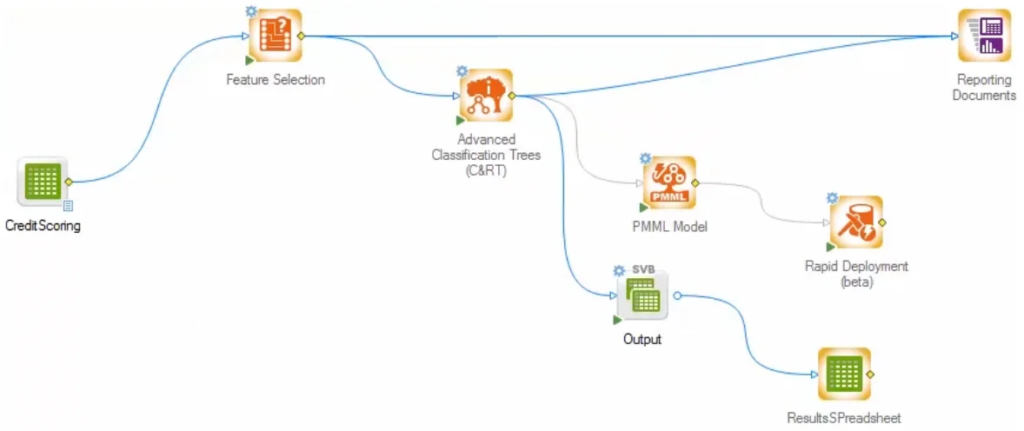TIBCO Data Science Model Operations
Update solution on January 17, 2020
TIBCO Data Science is an analytics and data science platform with a notably broad remit. The product’s features include self-service data preparation, a wide range of functions for developing analytic models, natural language processing, in-database analytics, real-time scoring, a built-in rules engine, support for languages such as R and Python as well as PMML (predictive modelling mark-up language), robust visualisation capabilities and a large number of connectors (both to a variety of data sources and to other tools).
However, in this report we will be focusing on its support for model management. We are particularly interested in examining the product’s capabilities for scaling up from a mere handful of models to hundreds, thousands, or even tens of thousands; deploying, tracking, auditing and governing models across the enterprise; and exposing both data science modelling techniques and the models themselves to a wider audience in such a way that business users can take advantage of them, thus breaking out of the ‘data science silo’ and maximising the benefits of data science modelling to your organisation.
The core of model management in TIBCO Data Science is the model flow. As seen in Figure 1, this is essentially a form of workflow, created within Statistica, a component of TIBCO Data Science, using a no-code GUI. These flows contain data inputs, models and outputs (shown in Figure 1 in green, orange and purple, respectively) as well the standard flow controls. Business logic can be implemented within a workflow via a rules node, and the flows themselves can be saved as templates and reused inside other model flows. The latter capability is particularly valuable because it allows dedicated data scientists to create complicated, in-depth models and flows, before allowing business users to situate them within the appropriate business processes.

Fig 01 – A model flow in TIBCO Statistica
Models and model flows are centrally stored and managed within the platform and accessed via a file-tree structure. Models are versioned, with all previous versions stored within the platform, available to be accessed, deployed or reverted to, as necessary. Third party models (that is, models not created within the data science platform – all standard languages are supported) can also be imported into the platform.
Models and flows held within TIBCO Data Science can be deployed across the broader range of TIBCO products. For example, you could publish your models to the Artifact Management Server, a common model repository, to expose them to TIBCO Streaming (formerly known as StreamBase) for use with streaming analytics, or send them to Spotfire to drive data visualisations. You can also monitor and retrain models en masse via the Monitoring and Alerting Server (a component of TIBCO Data Science Operations), and models can be exposed for external use via OData.
TIBCO Data Science also features a number of collaborative capabilities between data scientists and business users that come into play with model management. Models and model flows (as well as other objects, such as projects) can be shared and worked on collaboratively across the platform. Moreover, models and model flows can be parameterised and tailored to business users before being exposed to them. This might include only exposing a subset of the model’s parameters, renaming fields to make them more easily understood, setting default values, and so on. The aim is to expose all the functionality that a business user needs, and no more, thereby making their interactions with the model as simple as possible. Once a model has been tailored in this way, it can be saved as a template and shared as needed. This is also tightly integrated with TIBCO Spotfire so citizen data scientists can run data science workflows directly from a Spotfire dashboard.
TIBCO Data Science is a platform for analytics in the broadest possible sense. It’s undeniable that machine learning, AI and data science are becoming ever more popular and important parts of analytics, and as a result, if you are leveraging analytics you are almost certainly leveraging analytical models. The sheer amount of these models is growing: we expect large organisations to be utilising thousands or even tens of thousands of models in the near future, if they aren’t already. At that quantity, model operations and management is essential, and TIBCO provides it along with all of its other capabilities.
What’s more, as modelling becomes more common and more popular, data scientists will be more needed (and therefore more in demand) than ever. While TIBCO (or other product) can eliminate the need for data scientists, its collaborative capabilities do enable more effective and efficient use of the data scientists and citizen data scientists you have, by enabling business users to take a larger role in the modelling process. This maximises the value of your data scientists, while providing a measure of self-service for your business users.
The Bottom Line
Model management will soon be essential for any serious analytics solution. TIBCO Data Science not only has it, but integrates it with a wealth of other analytics tools and products.
Related Company
Connect with Us
Ready to Get Started
Learn how Bloor Research can support your organization’s journey toward a smarter, more secure future."
Connect with us Join Our Community
